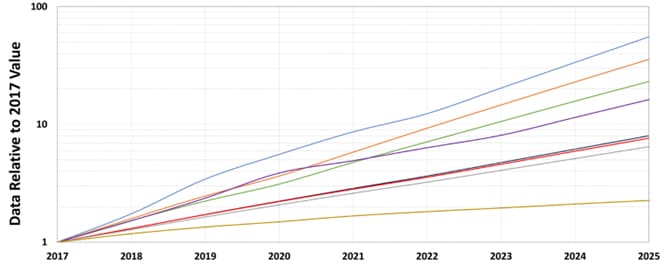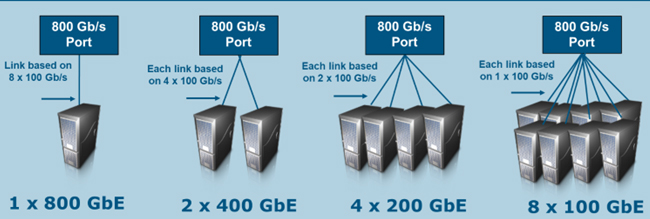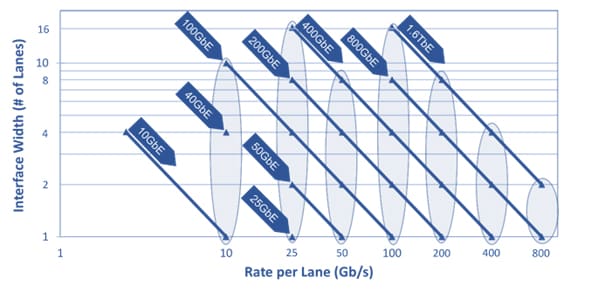Over the past 22 years, a new, higher speed of Ethernet has been introduced every 7 to 8 years. In 2002, 10 Gigabit per second Ethernet (GbE) was introduced, followed in 2010 with 40 GbE and 100 GbE, and then 200 GbE and 400 GbE in 2017. This culminated this year with the introduction of 800 GbE.
Why? Simply stated, the industry needed it!
Ethernet is often considered “the plumbing of the Internet” and has supported an undeniable “up and to the right”, i.e. exponential, bandwidth growth. After 10 GbE, it was observed that core networking was doubling approximately every 18 months while servers were doubling every 24 months. This is what led to the introduction of 40 GbE and 100 GbE. After the development of these two Ethernet rates, the first IEEE 802.3™ Ethernet Bandwidth Assessment forecasted that on average bandwidth needs would grow by a factor of 10 every 5 years. Armed with this knowledge, the IEEE 802.3™ Ethernet Working Group developed 200 GbE and 400 GbE.
The latest IEEE 802.3™ Ethernet bandwidth assessment noted that by 2025, bandwidth growth of various applications would grow anywhere from 2.3x to 55.4x the traffic levels of 2017. The findings of this assessment are illustrated in Figure 1.

Recognizing the immediate industry need for 800 GbE, the IEEE P802.3df™ Task Force emerged. This task force was composed of subject matter experts from a variety of backgrounds: users and producers of systems and components for high-bandwidth applications, such as cloud-scale data centers, internet exchanges, colocation services, content delivery networks, wireless infrastructure, service provider and operator networks, and video distribution infrastructure. This diverse pool of talent enabled Ethernet to continue its evolution to satisfy the next generation bandwidth needs of industry.
Given industry acceptance of 8-lane electrical and optical solutions, the IEEE P802.3df™ Task Force was able to leverage a number of Ethernet standards that defined 100 Gb/s electrical and optical signaling. The different IEEE 802.3™ standards leveraged are noted in Table 1.
| Ethernet Standard | Description |
|---|---|
| IEEE Std 802.3ck™-2022 | Definition of electrical signaling over chip-to-module and chip-to-chip electrical interfaces (AUI) and electrical backplanes (BP) and copper (CU) cables. |
| IEEE Std 802.3bs™-2017 IEEE Std 802.3cu™-2021 |
Definition of 100 Gb/s signaling over single mode fiber (SMF). |
| IEEE Std 802.3db™-2022 | Definition of 100 Gb/s optical signaling over multi-mode fiber (MMF). |
Building on these standards, IEEE 802.3df™-2024 was developed in approximately 16 months, 4 months ahead of its adopted schedule. The full list of electrical interfaces and physical layer specifications defined in the new standard are summarized in Table 1. By leveraging these standards, implementors will be able to re-use existing IP and quickly introduce new products compatible with the new standard.
| Ethernet Rate | AUI | BP | Cu Cable | MMF 50m | MMF 100m | SMF 500m | SMF 2km |
|---|---|---|---|---|---|---|---|
| 400 Gb/s | — | — | — | — | — | — | 4 pairs |
| 800 Gb/s | 8 lanes | 8 lanes | 8 pairs | 8 pairs | 8 pairs | 8 pairs | 8 pairs |
Addressing the New Paradigm
IEEE 802.3df™-2024, with its parallel x8 structure for 800 GbE, enables Ethernet to address the reality of today’s networks where dual 400 GbE links are already being supported in a single x8 copper or optical connection. While this helped enable higher 400 GbE port density, it has emerged into even greater flexibility for configuring a port. Consider a given eight-lane port: it could be configured to support any of the following scenarios: a) one eight-lane implementation; b) two four-lane implementations; c) four two-lane implementations; d) eight one-lane implementations (see Figure 2).
Thus, in combination with the standards noted in Table 1, a network architect can configure a single port to support standardized 100 GbE, 200 GbE, 400 GbE, or 800 GbE. This enables leveraging economies of scale to drive costs down throughout the entire ecosystem.

Looking Ahead
As previously highlighted from the latest IEEE 802.3™ Ethernet bandwidth assessment, by 2025 traffic levels are forecasted to be 2.3x to 55.4x the observed levels of 2017. While it is anticipated that IEEE 802.3df™-2024 will provide relief to a number of applications, the continuing exponential growth of industry bandwidth needs will necessitate the next rate of Ethernet sooner than the historical approximate 7 years that has been observed since 10 GbE.
The IEEE P802.3dj 200 Gb/s, 400 Gb/s, 800 Gb/s, and 1.6 Tb/s Ethernet Task Force emerged out of the IEEE P802.3df™ Task Force. The focus of this force will be on developing solutions based on 200 Gb/s or greater electrical and optical signaling. Those familiar with Ethernet are familiar with its propensity to provide upgrade paths. Therefore, the IEEE P802.3dj™ Task Force will be focused on solutions based on 1, 2, 4, and 8 lanes. As illustrated in Figure 3, with a lane rate of 200 Gb/s, solutions for 20 GbE, 400 GbE, 800 GbE, and the next Ethernet rate, 1.6 Tb/s, will be developed. This project is currently scheduled for completion in 2026. View More Information on This Project

Author: John D’Ambrosia, IEEE P802.3df Task Force Chair








